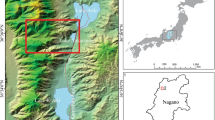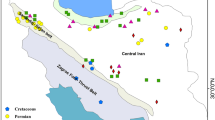Abstract
This paper details with the beach placer deposit of Kantiaghar area of Ganjam district, Odisha. In Odisha, Atomic Mineral Division (AMD) has explored a stretch of about 150 km from south of river Mahanadi to Orissa-Andhra Pradesh border. Here the potential deposits posses a grade range from 5 to 30%. The heavy minerals are present in the beach and dunes around Kantiaghar, which is in the NE of Rusikulya river mouth. The prospect extends in NE-SW direction having a width of about 1000m.Heavy minerals occur up to a depth of 10 m. A total of 12 samples were collected at an interval of half km along the shore of Bay of Bengal. The heavy minerals are mostly of 170 micron size. The average heavy mineral content of Kantiaghar beach is 67%. The heavy minerals constitute sillimanite, ilmenite, garnet, rutile, monazite and zircon. Along with these minerals trace amounts of magnetite and hornblende is also present. Leucoxene and anatase are reported from this beach. The average percentage of sillimanite is 50.15%, ilmenite is 19.47%, garnet is 13.5%, and rutile is 3.7%, monazite is 1.21% and zircon is 0.93%, the number percentage of the heavy minerals clearly shows that the concentration of sillimanite is high.
Based on field relationships and mineralogy it can be interpreted that the river systems draining the Eastern Ghat, their metamorphic associates and basic intrusives account for these deposits.
Similar content being viewed by others
References
Babrubahan, R. (1989) Origin and Evolution of the sand dune deposits of Ganjam coast, Odisha, India. Atomic Mineral Division, Hyderabad.
Bosworth, T.O. (1913) The Heavy Minerals in the sandstones of the Scottish carboniferous rock. Geologists’ Assoc. (London) Proc., v.24, pp.57–61.
Darby, D.A. and Yuwen, T. (1986) Variation in ilmenite composition within and among drainage basins; implications for provenance. Jour. Sediment. Petrol., v.57(5), pp.831–838.
Fox, C.S. (1931) The Gondwana system and related formations. Mem. Geol. Surv. India, v.58, pp.1–113.
Grigsby, J.D. (1990) Detrital magnetite as a Provenance indicator. Jour. Sediment. Petrol., v.60, pp.940–951.
Hubert, J.E. (1962) A zircon–tourmaline maturity index and the interdependence of the composition of heavy minerals assemblage with the gross compositions and texture of sandstones. Jour. Sediment. Petrol., v.32, pp.440–450.
Indians Minerals Year Book (1989) Issued by Bureau of Mines, Nagpur.
Komar, P.D. and Wang, C. (1984) Processes of selective grain transport and the formation of placers on beaches. Jour. Geol., v.92(6), pp.637–655.
Kudrass, H.R. (1987) Sedimentary models to estimate the heavy mineral potential of shelf sediments, Netherlands. Marine Minerals, pp.39–56.
Malathi, J., Selvasekarapandian, S., Brahmanandhan, G.M., Khanna, D., Meenakshisundaram, V. and Mathiyarsu, R. (2005) Study of radionuclide distribution around Kudankulam nuclear power plant site. Radiat. Prot. Dosimetry, v.113(4), pp.415–420.
May, J.P. (1973) Selective transport of heavy minerals by shoaling waves, Sedimentology, v.20, pp.203–211.
Mohanty, A.K., Das, S.K., Vijayan, V., Sengupta, D. and Saha, S.K. (2003) Geochemical studies of Monazite sands of Chhatrapur beach placer deposit of Odisha, India by PIXE and EDXRF method. Nuclear instruments and methods in physics research section B, v.211(1), pp.145–154.
Murthy, M.V.N. (1964) Zircons, criteria for deciphering magmas and migmas. Proc. 22nd Internat. Geological Congress, v.16, pp.410–423.
Nair, A.G., Suresh, B.D.S., Vivekanandan, K.L. and Vlach, S.R.F. (2006) Differential alteration of ilmenite in a Tropical Beach placer, Southern India: Microscopic and electron probe evidences. Resource Geol., v.56(1), pp.75–81.
Prakash, T.N. and Abyverghese, P. (1987) Seasonable beach changes along Quilon destrict coast, Kerala. Jour. Geol. Soc. India, v.29, pp.390–398.
Rao, D. and Krishnaiah, S. (1989) Heavy Mineral content and textual characteristics of coastal sands in the Krishna–Godavari, Gosthani Chmpavathe and Panna river deltas of Andhra Pradesh, Nov–Prakash Printing Press, Bombay, v.2, pp.147–155.
Shepard, F.P. and Young, R. (1961) Distinguish between beach and dune sands. Jour. Sediment. Petrol., v.31, pp.196–214.
Siddiqui, A.S. (2001) Indian Rare Earths Limited, Geology of Orissa.
Sindowski, K.H. (1949) Results and problems of heavy mineral analysis in Germany–A review of sedimentary Petrological papers, Jour. Sediment. Petrol., v.19, pp.129–130.
Venkataratnam, S. and Rao, A.T. (1968) Zircons from beach sands along east coast of India. Indian Minerals, v.9(182), pp.20–29.
Yourkaya, R.M. (1970) Comparison of post sedimentary alteration of oil–gas and water bearing rocks. Sedimentology, v.15, pp.53–68.
Author information
Authors and Affiliations
Corresponding author
Rights and permissions
About this article
Cite this article
Nayak, B., Mohapatra, R.K., Mangaraj, M. et al. Mineralogical Characterisation of Beach Placers at Kantiaghar in Ganjam District, Odisha. J Geol Soc India 93, 194–198 (2019). https://doi.org/10.1007/s12594-019-1150-8
Received:
Accepted:
Published:
Issue Date:
DOI: https://doi.org/10.1007/s12594-019-1150-8




